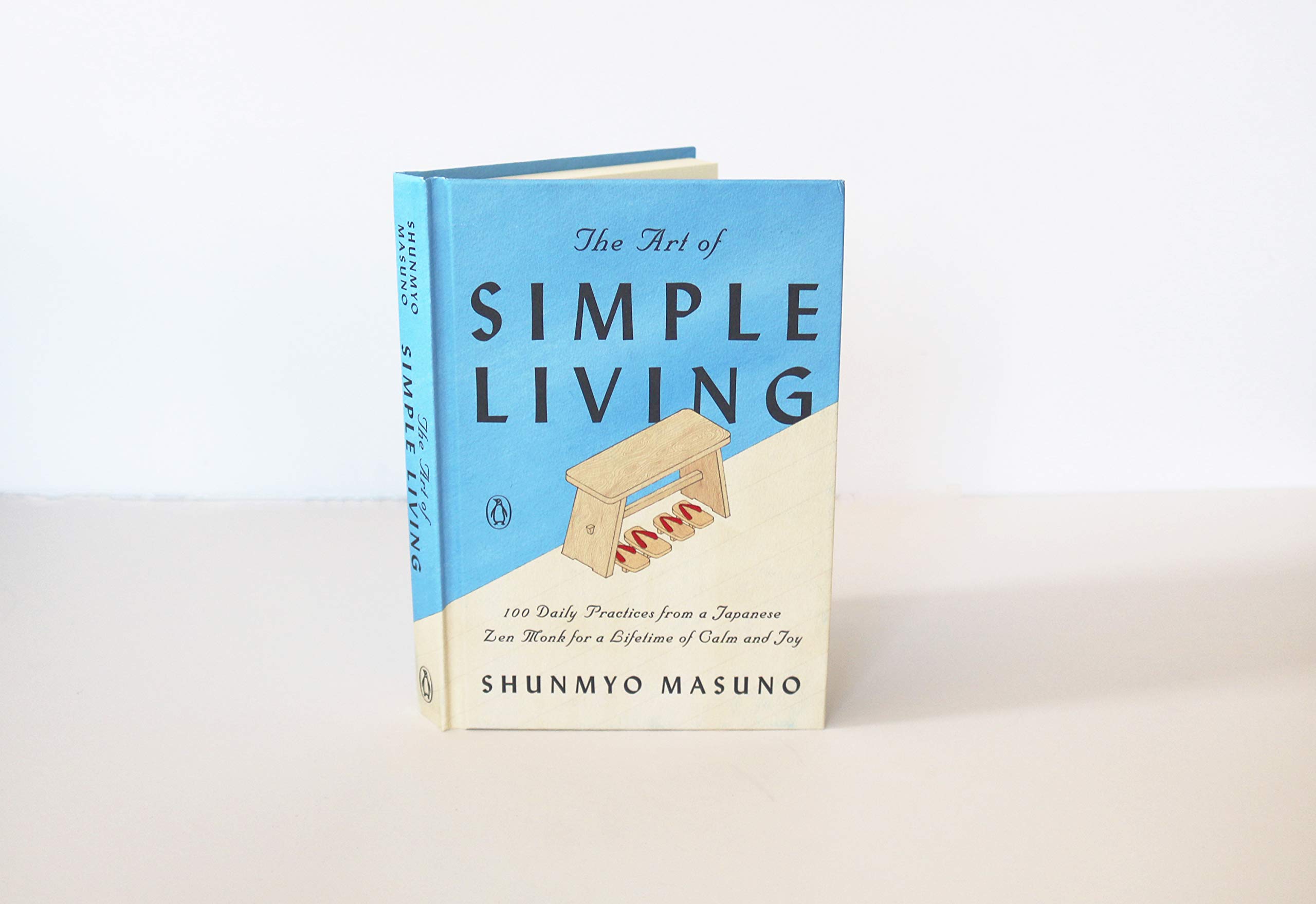“Zen: The Art of Simple Living” by Shunmyo Masuno is a beautiful and inspiring book that offers practical guidance on how to live a more mindful and fulfilling life. The author, a Zen priest and garden designer, draws on his extensive knowledge and experience to share insights into Zen philosophy and how it can be applied to everyday life.
The book offers readers practical insights and guidance on cultivating greater simplicity and mindfulness. It covers a wide range of topics, from the importance of decluttering and simplifying one’s surroundings to the value of cultivating a sense of gratitude and compassion. People interested in personal growth, spirituality, or mindfulness may find the book especially valuable because it provides concrete tools and practices for developing greater self-awareness, reducing stress, and finding meaning and purpose in everyday life. The book may also appeal to readers interested in Japanese culture or aesthetics, as it draws on Zen traditions and principles deeply rooted in Japanese history and philosophy.
Overall, the book, “Zen: The Art of Simple Living”, offers a refreshing and accessible perspective on how to live a more fulfilling life, which may be of interest to anyone looking to simplify their life. While reading it, I found some advice to be closely related to a few common phenomena we see today. In this article, I will discuss Zen philosophy with clear examples to show how an age-old philosophy can still be relevant and applicable in modern times.
About the Author
Shunmyo Masuno is a Zen priest, garden designer, and professor of environmental design at Tama Art University in Tokyo, Japan. He was born in Yokohama in 1953 and received his training as a Zen priest at Kenchoji Temple in Kamakura, one of the oldest and most prestigious Zen temples in Japan. In addition to his work as a priest, Masuno is known for his innovative and minimalist approach to garden design, which he visualizes as a form of Zen practice. He has designed gardens in Japan, Europe, and the United States, and his work has been featured in numerous publications and exhibitions. His literary works on Zen philosophy and design, including the book in conversation, have been translated into multiple languages and become a bestseller in many countries. He is widely regarded as “Japan’s leading garden designer”.
What is Zen Philosophy?
Before we get there, let’s try to quickly understand what Zen philosophy is. It is a form of Mahayana Buddhism that originated in China and later spread to Japan and other parts of the world. At its core, Zen focuses on the practice of mindfulness and meditation to cultivate a deeper understanding of the true nature of reality to achieve enlightenment.
One of the key principles of Zen is the concept of non-duality, which suggests that all things are interconnected and inseparable and that there is no fundamental separation between self and other or between subject and object. Zen also highlights the importance of living in the present moment and letting go of attachments to past or future events.
Zen practice often involves seated meditation, or zazen, in which the practitioner seeks to quiet the mind and focus on the present moment. Zen sees mindfulness in everyday life as important and encourages practitioners to approach even the most mundane activities with a sense of presence and awareness.
Overall, Zen philosophy is a way of life that seeks to develop wisdom, compassion, and inner peace through mindfulness, meditation, and a deep understanding of the interconnectedness of all things.
Summary and Structure of the Book Zen: The Art of Simple Living
The book is divided into four sections, each covering a different aspect of Zen philosophy. The first section, “Habits,” explores the importance of simplifying one’s surroundings and creating healthy daily habits that promote well-being and self-awareness. It covers 30 ways to energize one’s ‘present self’ by making subtle shifts in habits or behavior.
The second section, “Perspectives,” offers insights and guidance on cultivating a more mindful and compassionate perspective towards oneself and others, emphasizing the value of non-duality and interconnectedness. A set of 30 pieces of advice again inspires confidence and courage for living and embracing changes.
The third section, “Interactions,” focuses on the importance of fostering meaningful and fulfilling relationships with others. This epitomizes the role of communication, empathy, and compassion in promoting positive interactions and contains 20 tips.
The fourth and final section, “Living in the Present Moment,” offers practical tools and practices for practicing mindfulness and living fully in the present moment. It encapsulates the importance of developing a sense of gratitude and appreciation for the beauty and wonder of everyday life.
Modern-day Applications of Zen Philosophy

(a) Minimalism: Simplify your life by letting go of unnecessary possessions and distractions. I encourage you to focus on the things that truly matter and avoid getting caught up in the cycle of consumerism and materialism. This echoes the principles of minimalism, living with less and being intentional about the things we own and consume. You can start by donating one item from your never-used or less-used bundle of clothes per month to someone who needs it.
(b) Marie Kondo-ing your surroundings: The notion of decluttering and organizing one’s living space in order to create a sense of calm and order. This is similar to the “KonMari” method popularised by Marie Kondo, which involves purging one’s belongings and organizing them in a way that brings joy and reduces clutter. Take 10 minutes each day to tidy up a specific area. Start with your work desk. Change the orientation of furniture every 3 or 6 months to discover a new-found sense of space and room.
(c) Joy of idleness or doing nothing: Masuno encourages readers to embrace moments of idleness and polish a sense of ease and relaxation in their daily lives. He suggests that by letting go of the need to be constantly productive or busy, we can tap into a deeper sense of joy and contentment. Take 5 minutes each day to simply breathe and be present. When you wake up in the morning, look out the window and listen intently to the morning chatter.
(d) Stoicism: Masuno’s emphasis on accepting the impermanence of all things and cultivating a sense of detachment from external circumstances echoes the principles of Stoicism. Like Stoic philosophers, Masuno encourages readers to focus on what is within their control and to let go of attachment to external outcomes. Practice gratitude each day for what you have. The best way to achieve this would be through journaling.
(e) IKEA effect: The tendency of people to value things more highly when they have put effort into creating or building them. Masuno suggests that by taking the time to create things manually or by investing ourselves in a particular activity or pursuit, we can deepen our sense of connection and appreciation for the world around us. Dedicate 15 minutes each day to a creative project – drawing, gardening, cooking, etc. Do chores around the house to forge a deeper bond – tidy rooms, fix light bulbs, or paint walls.
(f) Realism: This refers to seeing things as they are without getting caught up in illusions or delusions. He exposes the readers to a sense of realism and asks them to approach the world with clear eyes and an open mind. You can practice this by consciously putting yourself in somebody else’s shoes that you met that day – your vegetable shopkeeper, delivery person, or office colleague. Asking genuine questions and listening with an open mind also helps.
(g) Beauty lies in the eye of the beholder: Masuno suggests that beauty is subjective and that we each have the power to find beauty and joy in the world around us. Not everyone sees beauty the same way, but beauty is there for everyone in everyday things, such as a beautiful sunset or a blooming flower. This can also be practiced through journaling. Notice one beautiful thing each day, take a moment to appreciate it, and put it on paper to remember.
(h) Today is a gift: As Master Oogway expertly puts it in Kung Fu Panda (2008)
“Yesterday is history,
tomorrow is a mystery,
and today is a gift…
that’s why they call it present”
Focus on the here and now, and let go of regrets about the past and worries about the future. Take 5 minutes each day to introspect on what you can do today to pursue your long-term goals. Use it wisely, and it will open new doors for you.
(i) Alone but not lonely: Masuno suggests that it is possible to foster a sense of contentment and peace even when we are alone. He encourages readers to embrace solitude as a chance to recharge, reflect and develop a sense of self-reliance and inner strength. Embrace solitude as a chance to recharge and reflect. Spend 10 minutes each day in quiet reflection. Carve out some “me time” and spend this on your own terms. Date yourself from time to time with a book, comfort food, and some soulful music away from prying eyes.
(j) KISS – Keep it simple silly: Masuno’s overall message is one of simplicity and mindfulness. He encourages readers to let go of complexity and business and focus on things that truly matter in life. By keeping things simple and straightforward, we hone a sense of clarity and ease in our daily lives. Choose one task each day that you can let go of or delegate to someone else. Don’t try to multitask; focus on one thing at a time, give your best, and enjoy while you are at it.
Why Should You Read the Book Zen: The Art of Simple Living?
Zen: The Art of Simple Living works because of its focus on simplicity. Masuno tells a story through many small excerpts – how to declutter our physical space and minds and nurture a sense of mindfulness and gratitude in their daily lives. Each tiny excerpt comes with examples and a lovely message at the end of it. The book focuses on getting people to think rather than providing all the answers outright, although he does provide practical tips on achieving zen in everyday life through meditation and simple rituals like tea ceremonies.
The book is beautifully designed and illustrated, with stunning photographs of Japanese gardens and landscapes on every other page, making it a pleasure to read. This adds to the overall sense of calm and serenity that the book conveys when you are going through it. I will recommend you go for a physical copy of the book over an online one.
Also, Read – Critically Analysing the Poem “since feeling is first” by E. E. Cummings
While the book is certainly thought-provoking, it is not without its flaws. For one, some of the advice in the book can come across as simplistic, and it may not be applicable or relevant to everyone’s lives. Additionally, the book’s focus on Zen philosophy may not resonate with every reader, especially those unfamiliar with or interested in Eastern spiritual traditions.
Overall, Zen: The Art of Simple Living is a beautifully presented and inspiring book that offers valuable insights into living a more mindful and fulfilling life. While it may not be actionable for everyone, for those looking to simplify their lives and improve inner peace and contentment, this book is a must-read. It is a well-crafted reminder to slow down and consider different perspectives in life.

